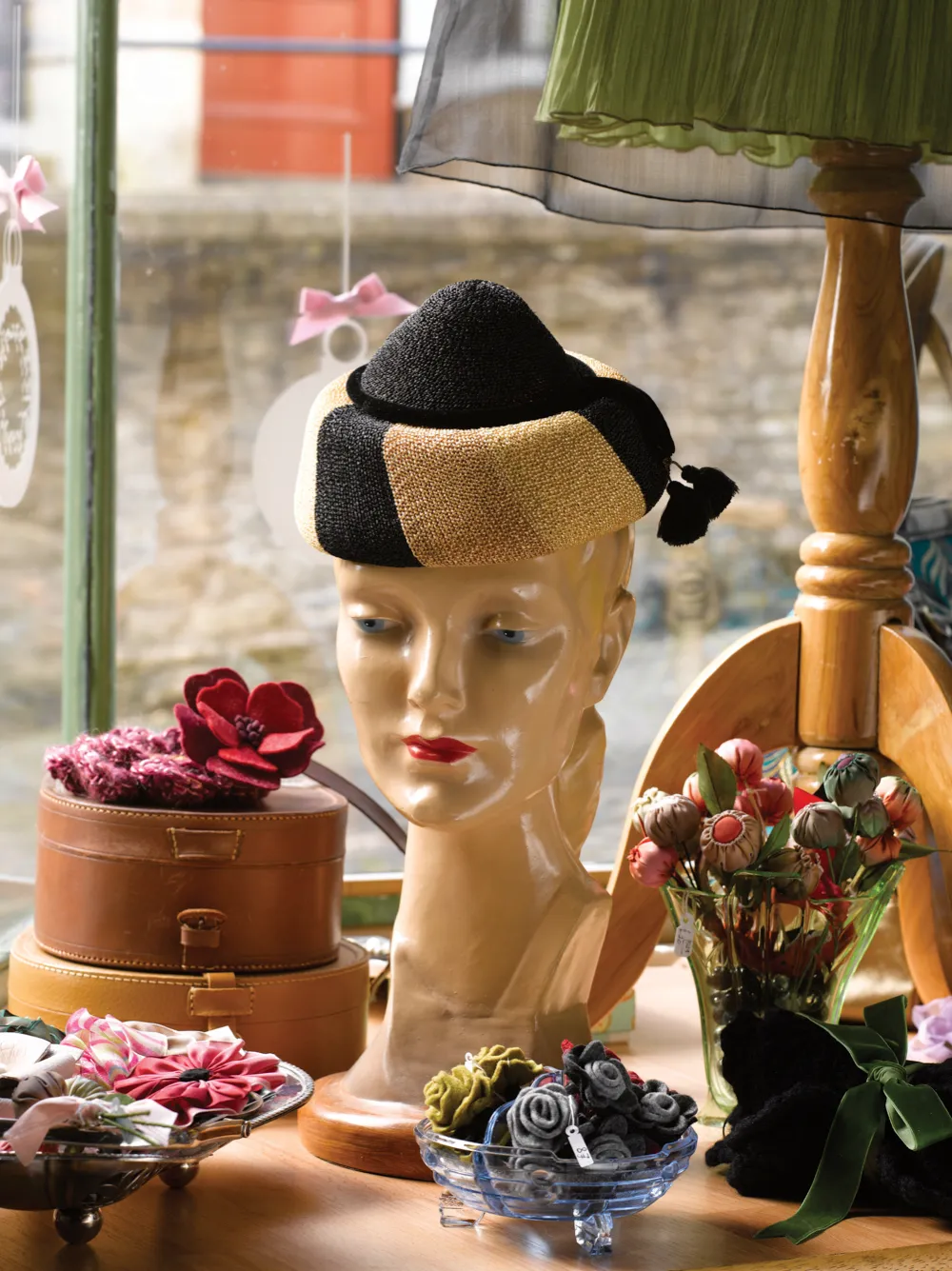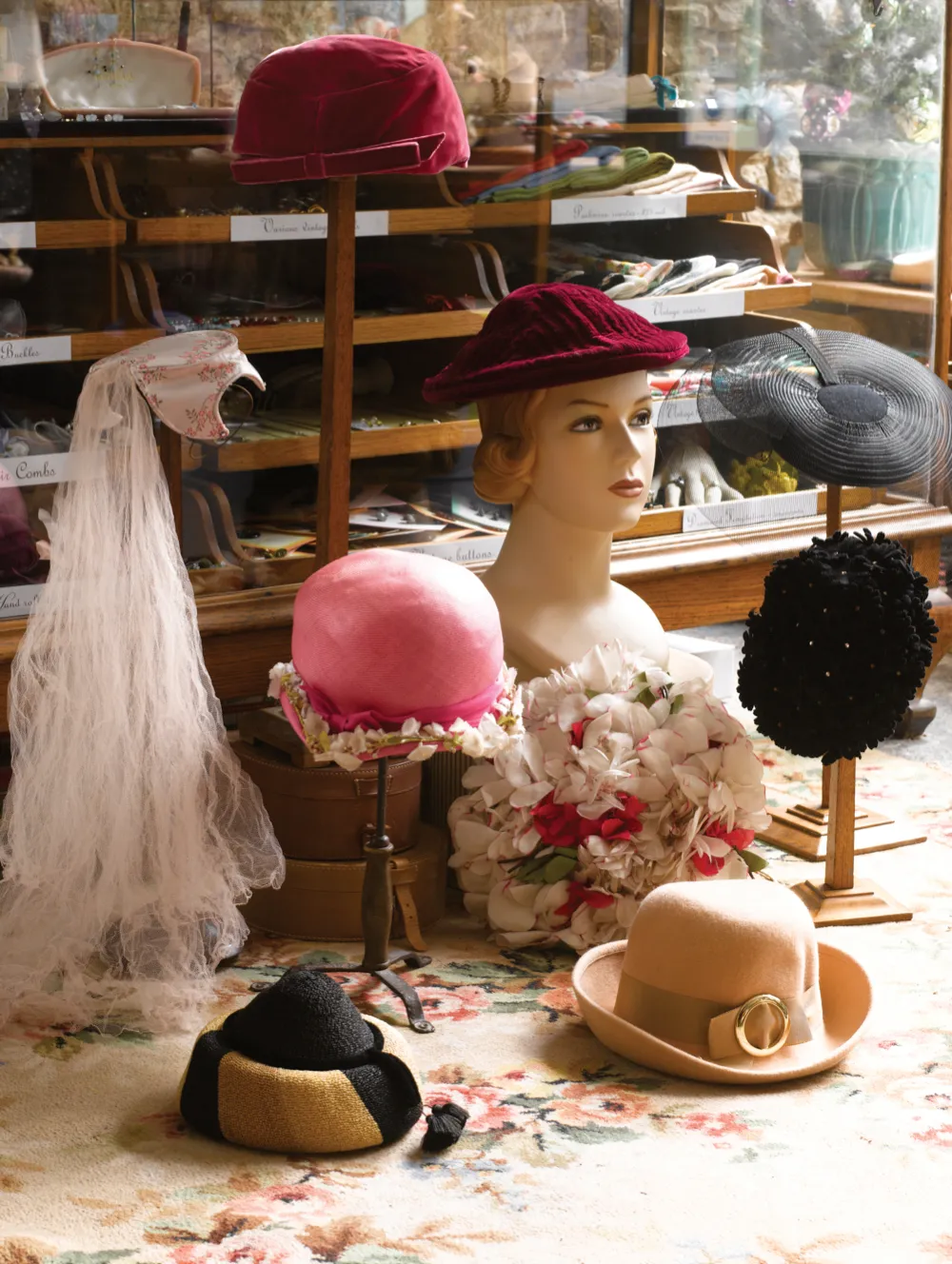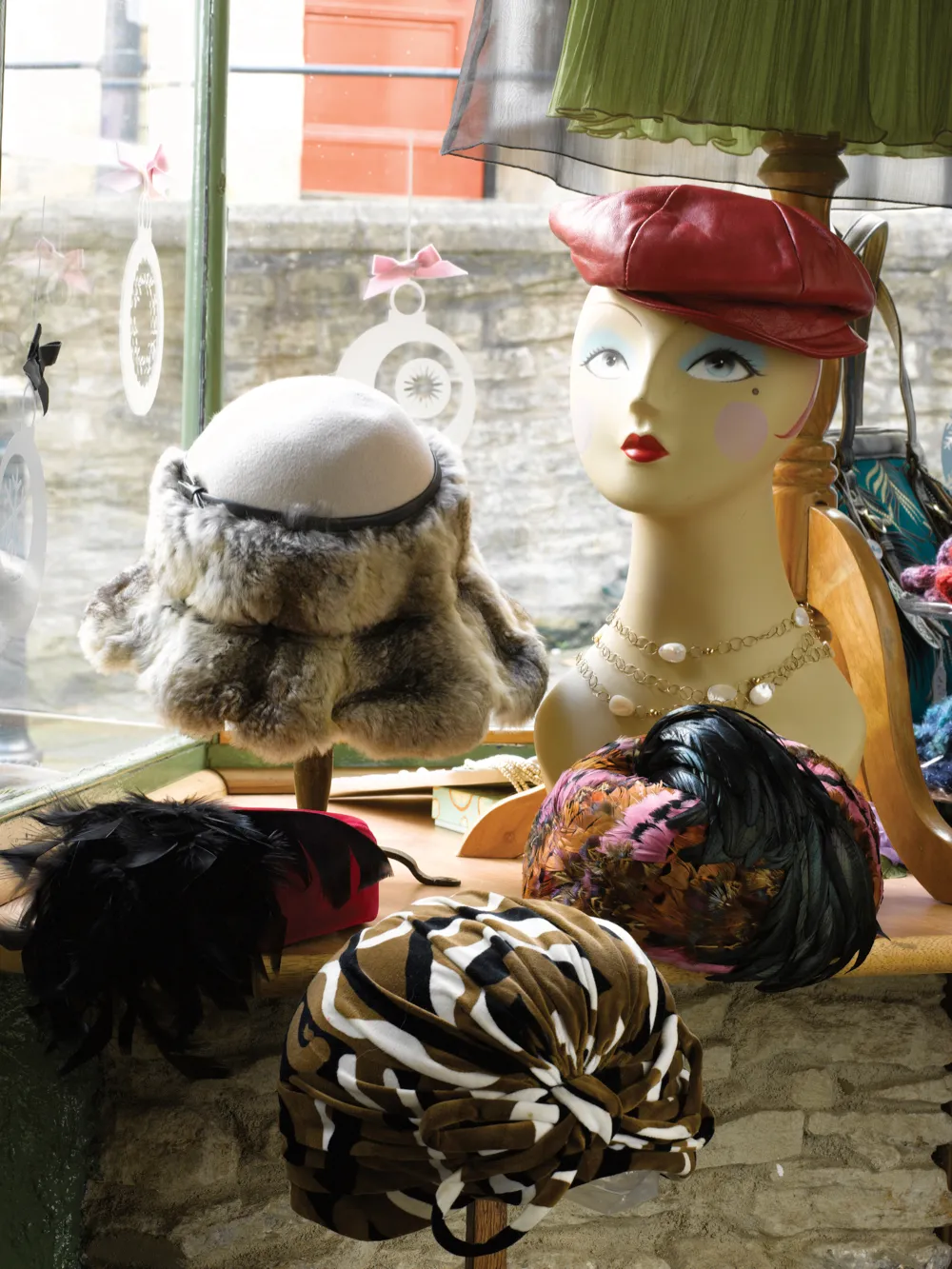Vintage clothes dealer Pat Oldman has been collecting hats for 30 years. ‘I just love them,’ she says. ‘They’re such beautiful objects.’ She hoards her three favourite Edwardian stunners and hangs the rest of her collection high up in her West Yorkshire shop, away from customers’ eager hands. ‘I have a hat tree that holds about 10, but I often tell people the others are just not for sale.’
Pat is as rare as an osprey feather in the world of fashion collecting, since in recent years hats have too often been seen as the poor relation of handbags and shoes, a perspective certainly not shared by Stephen Jones, one of the world’s foremost hat designers.
‘A hat is the cherry on the cake; the dot on the ‘i’; the exclamation mark,’ he says. ‘In fact, a hat is often the raison d’etre of a fashionable outfit.’
The height of fashion
Hats, of course, have been worn for thousands of years for safety, status and warmth, but it’s only recently that they’ve become covetable designer objects in their own right. Though the word ‘millinery’ derives from the Italian town of Milan it was, ironically, the French aristocracy in the 18th century, so soon to lose their heads, who first took the humble head covering and turned it into a must-have fashion accessory, with the skilful modistes at the court of Louis XV creating whimsical fantasies of lace, ribbon and straw.
The heyday of the hat was the 19th century, as mass production made interesting headgear more widely available and an ever more elaborate etiquette dictated when and where each should be worn. By the end of the Victorian period, no-one with the slightest claim to respectability would have dreamt of being seen hatless in public and stylish women of rank had an extensive range of millinery to match their kaleidoscopic wardrobes.
The demure bonnet, which protected both modesty and the complexion, was one of the more dominant styles, and straw and silk hats were often elaborately decorated with feathers, flowers and even whole birds. By the turn of the century, the Edwardians, those masters of excess, had taken the look to extremes and elaborately plumed extravaganzas could command outrageous sums of up to £100. So ruthless was the demand for feathers that Queen Alexandra, wife of Edward VII, forbade the wearing of rare osprey plumes at court.

Modern influences
Even when, after WWI, clothes became more informal, the hat lost none of its appeal and each succeeding decade offered up its fashion icon to popularise the look of the moment. In the Twenties and Thirties, society hostess Lady Diana Cooper set the pace for the coolie and the picture hat; in the Forties and Fifties, film stars such as Joan Crawford and Deborah Kerr made the turban the ultimate solution to a bad hair day; while in the Sixties it was America’s glamorously youthful First Lady, Jackie Kennedy, who ensured the pillbox was seen on matrons from New York to LA.
By the Sixties, though outrageous confections by society designer David Shilling could still be seen regularly at Ascot (the two-metre high giraffe hat his mother wore to the races in 1971 was so enormous it snapped in the wind), for most people, a hat had become an optional extra. A pretty face, however, could still launch a thousand trends and the newly married Princess Diana single-handedly revived the felt hat when she donned a chic little number by John Boyd on the eve of her wedding to Prince Charles.
Hat hoarders
Collecting antique and vintage hats is in many ways a more affordable pastime than buying new designer models, but provenance and maker play a crucial role in their value. ‘Anything by a famous name is collectable,’ says Oriole Cullen, curator of Fashion and Textiles at the V&A. ‘The big couture houses such as Dior, Schiaparelli and Balenciaga are obviously well known, but other leading milliners include Mr John and Lilly Daché in New York; Bes-Ben in Chicago; Caroline Reboux in Paris, and Aage Thaarup, Simone Mirman and John Boyd in London.’
Finding one of these labels – such as Schiaparelli’s dashing pink copperplate – or a deluxe designer hat box – like Lilly Daché’s striking monochrome containers with their witty needle typeface – adds an extra frisson to the joy of collecting.
A capital investment
Hat collectors tend to divide into those who buy to wear and those who buy to store, but prices for both historic hats and more recent examples are rarely out of the everyday range. For those who want to accrue a collection rapidly, a clutch of fine Ascot hats by well-known Sixties’ designers such as Graham Smith and David Shilling can be picked up for as little £200-£300 at auction houses like Bonhams. And collectors on tighter budgets will find bargains for well under £100 on eBay and in vintage shops.
Occasionally, a rare example by a big name will fetch serious money: ‘A Dior “New Look” hat recently sold for about £1,000,’ says Patricia Frost, director of Fashion and Textiles at Christie’s. ‘And a beautiful 18Th-century chintz sun hat fetched a similar amount.’
But these prices pale into insignificance against the V&A’s recent purchase of a Dalí-inspired ‘shoe hat’ by surrealist designer Elsa Schiaparelli for £40,000.
Since the Eighties, London has been the centre of the world’s millinery, known for its daring, innovative and witty design. If you’re looking to invest in antique hats of the future the names to look out for include new arrival William Sharp and, of course, Philip Treacy, Vivienne Westwood and Stephen Jones himself. Finding a previously owned model by one of these designers, however, is not easy. Most owners, like Pat Oldman, like to hold onto their hats.
Hats through the ages
1920s-30s
By the Twenties, French couture houses such as Molyneux, Lanvin and Patou were selling hats alongside their dress collections, and the cloche became the flapper’s headgear of choice. This bell-like helmet was the perfect complement to the new rage for bobbed hair and an ideal foil to the painted face, as, for the first time, respectable young women were allowed to wear make-up.
Though the cloche was eventually reproduced in straw, it was most often seen in felt, ornamented with appliqué feathers or a diamond clip.

The Thirties saw the revival of the toque, a small hat worn at the side of the head, while Swedish screen idol Greta Garbo helped popularise the felt fedora. Paris remained the centre of the fashion world, and talented designers like Elsa Schiaparelli, part of the Surrealist circle, produced witty creations in the form of a birdcage, a shoe and a pincushion.
The vogue for jewel-trimmed turbans was made popular by Paris milliner Madame Agnès. America, too, had a thriving millinery industry and New York hatter Lilly Daché became famed for her snoods and delicate cocktail hats ornamented with silk flowers – not to mention Carmen Miranda’s towering turbans.
1940s-50s
During the early 1940s, wartime austerity demanded toned-down fashion, and the hat was almost superseded by the trend for snoods made from crocheted chenille, which gathered hair at the nape of the neck and were decorated with a flat bow or knots of flowers.
But in 1946, Spanish-born genius Balenciaga revived the hat’s popularity with a pillbox design, which complemented the sleek linearity of his couture. Madame Rochas used a lace pillbox by Legroux with matching lace-edged gloves to advertise her perfume in the same year, and Jackie Kennedy repopularised the trend in the 1960s. In fact, trends in millinery often have a long provenance.
‘Take for instance the working man’s flat cap worn by Ellen Terry in 1903 as motoring gear,’ says Joy Kleiner Meier, a lecturer in antique costume and fashion who also deals in vintage hats and clothes. ‘Schiaparelli reinterpreted it as high fashion in 1948. And then when it was worn by Jeanne Moreau in Jules et Jim in 1962, it became high-street fashion. Indeed, many contemporary designers use vintage hats as inspiration for their new collections.’
Post-war, the hat once more became very much part of the fashion silhouette. Donning a chic chapeau was a relatively inexpensive way to update last year’s look in a period of austerity. In 1947, Dior rescued millinery from the state of disarray with hats that crowned the head, echoing the wide sweep of the ‘New Look’ skirt.

1960s-70s
In 1966, British milliner David Shilling designed his first hat, aged just 12. His mother, Gertrude Shilling, fondly known as ‘ The Ascot Mascot’, had long been a fan of extravagant fashion, and her propensity for wearing over-the-top confections to Ascot inspired David to turn his hand to hats. Among his creations were a huge top hat with a rabbit popping out and an enormous apple shot through with an arrow in an homage to William Tell.
Shilling’s designs typified a rebellion against authority that epitomised the mood of the late Sixties, by which time youth culture had put paid to traditional formality and the need for a hat, and hairstyles increasingly took precedence over headware. Even so, designers like James Wedge, one of the first milliners to graduate from the Royal College of Art, and Graham Smith, who designed for Jean Muir and Zandra Rhodes and made hats for Elizabeth Taylor and Barbra Streisand, continued to produce covetable high-fashion hats. In the Seventies, the fashion for hats was upheld by the Royal Family, with designers like Simone Mirman and Aage Thaarup kept busy making hats for the Queen, the Queen Mother and Princess Margaret. Mirman worked closely with the Queen’s favourite clothing designer, Norman Hartnell, to create outfits that were press-friendly; the Queen’s face had to be seen from all sides. Due to a busy schedule, the Queen isn’t always around for fittings, so a replica of her head is kept at her milliner’s.
FIND OUT MORE
COLLECT
Christie's, 85 Old Brompton Rd, London (020 7930 6074) and Bonhams, The Old House, Station Road, Knowle, Solihull (01564 776151), both hold costume sales that include designer hats.
Echoes
650a, Todmorden, West Yorkshire. 01706 817505
Joy Kleiner Meier
Joy deals in vintage hats and lectures in antique costume and textiles (07952 151147) – see her at the Frock Me Fairs (020 7254 4054)
Shop
19 Christmas Steps, Bristol (0117 316 9421)
0113 274 8494
STYLING: Charis White
PHOTOGRAPHY: Catherine Gratwicke
